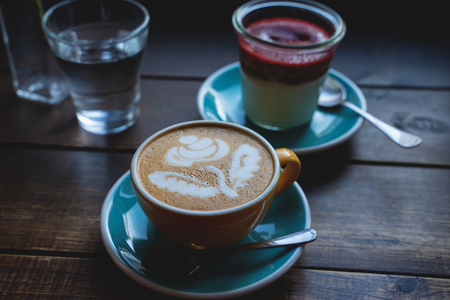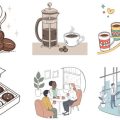Introduction to Cafetière Brewing
There’s something undeniably comforting about the gentle ritual of making coffee with a cafetière, or French Press, especially in British households. Over the years, this timeless brewing method has become a beloved staple in UK kitchens, cherished for its simplicity, elegance, and the rich, aromatic cup it produces. For many families—mine included—the familiar plunger and glass jug hold more than just coffee; they symbolise cosy mornings, weekend gatherings, and quiet moments shared at the kitchen table. The cafetière’s popularity is woven into the fabric of daily life here in Britain, where a good cup of coffee often brings people together and marks the start of a new day. In this article, we’ll explore not only why the cafetière holds such a special place in our homes but also take a thoughtful look at its environmental impact within the unique context of UK households.
2. Cafetière Brewing Process and Materials
If you’re a coffee lover in the UK, chances are you’ve come across the cafetière—also known as the French press. From a mum’s perspective, I find it’s one of the most accessible and family-friendly ways to enjoy freshly brewed coffee at home. Here’s a warm walkthrough of how it works, what it’s made from, and how it stands out compared to other popular brewing methods in British households.
The Basic Steps of Cafetière Brewing
Brewing with a cafetière is simple and straightforward—perfect for busy mornings or relaxed weekends with the family. You’ll need coarsely ground coffee, hot water (just off the boil), and your trusty cafetière. Here’s a step-by-step overview:
| Step | Description |
|---|---|
| Add Coffee | Scoop coarsely ground coffee into the bottom of the cafetière (usually about 1 tablespoon per cup). |
| Pour Water | Pour hot water over the grounds, ensuring all are evenly saturated. |
| Stir & Steep | Give it a gentle stir, pop on the lid, and let it steep for around 4 minutes. |
| Press & Serve | Slowly press down the plunger and pour out your fresh brew—ready to enjoy! |
Cafetière Materials: A Sustainable Choice?
Cafetière designs tend to be quite classic here in the UK, often crafted from durable glass, stainless steel, or sometimes even heat-resistant plastic. The main components include:
- Carafe: Usually borosilicate glass for heat resistance.
- Plunger: Stainless steel mesh filter attached to a rod and handle.
- Lid & Frame: Stainless steel or BPA-free plastic for structure and insulation.
This construction means that with proper care, a cafetière can last many years—minimising waste compared to some single-use alternatives. Plus, there’s no need for disposable paper filters or pods.
How It Differs from Other Popular UK Coffee Methods
British households might also have pod machines (like Nespresso), drip brewers, or instant coffee on hand. Here’s a quick comparison for an eco-conscious family:
| Method | Main Materials Used | Waste Produced |
|---|---|---|
| Cafetière | Glass/stainless steel/plastic; reusable metal filter | Coffee grounds only (compostable) |
| Pod Machine | Plastic/aluminium pods; machine parts | Podded waste (often non-recyclable) |
| Drip Brewer | Plastic/glass; paper filters required | Coffee grounds + used paper filters (sometimes compostable) |
| Instant Coffee | Tin/jar packaging; kettle needed | Packing waste; minimal daily waste once opened |
The cafetière stands out for its minimal environmental impact during use—just your spent grounds, which can go straight onto the compost heap! It’s a gentle choice for both your family routine and our lovely planet.

3. Waste and Disposal: The Grounds Reality
As a mum who loves her morning brew, I know that after each cafetière coffee, we’re left with those stubborn coffee grounds and sometimes used paper filters. But have you ever wondered what really happens to all this waste in UK households? It’s easy to just tip the grounds into the bin, but with a little effort, we can make much more responsible choices for our environment.
Coffee Grounds: Not Just Rubbish
In many British homes, coffee grounds end up in the general waste. Unfortunately, when sent to landfill, they contribute to methane emissions as they decompose without oxygen. However, there’s good news! Coffee grounds are packed with nutrients and can be a real treasure for your garden or allotment. If you have a compost bin—even a small one on your balcony—simply sprinkle used coffee grounds in. They add nitrogen to the compost and help create rich soil for plants. Even if you don’t have a garden, many local councils across the UK offer food waste recycling schemes that accept coffee grounds.
Practical Mum Tips for Greener Disposal
Here are some family-friendly ways I’ve found helpful:
- Compost at Home: Mix your used grounds with other food scraps and garden trimmings. It’s a brilliant way to cut down on kitchen waste and teach children about sustainability.
- Council Food Waste Bins: Most UK councils collect food waste separately. Pop your coffee grounds in these bins if home composting isn’t possible—check your council guidelines just to be sure.
- Around the House: Coffee grounds can deodorise your fridge or act as a natural scourer for pots and pans—a handy trick for busy mums!
What About Filters?
If you use unbleached paper filters with your cafetière, these can usually go straight into the compost or food waste bin too. Avoid plastic or bleached filters when possible—they’re less eco-friendly and harder to dispose of responsibly.
By making small changes in how we handle our daily coffee waste, we can teach our children about caring for the planet and reduce our household’s environmental footprint—one cup at a time.
Energy Use in British Kitchens
When we’re brewing our morning coffee in the UK, energy efficiency is an important part of our daily routine. As a mum who cares about both our family’s bills and the environment, I’ve often wondered how much energy we actually use when preparing that essential cup. Here, let’s compare the energy requirements of cafetière brewing with other popular methods found in British homes—specifically pod machines and kettles.
Comparing Coffee-Making Methods
It’s common knowledge that British kitchens are well-equipped with electric kettles—our national love for tea means almost every household has one! But many of us also use pod coffee machines for convenience, or a traditional cafetière (French press) for its simplicity and eco-friendliness. Each method uses energy differently, depending on how much water is heated and how efficient the appliance is.
| Brewing Method | Typical Appliance Power (Watts) | Average Brew Time (Minutes) | Estimated Energy per Cup (kWh) |
|---|---|---|---|
| Cafetière (using kettle) | 2000-3000 | 2-3 | 0.04-0.06 |
| Pod Machine | 1400-1600 | 1-2 | 0.03-0.05 |
| Kettle (for instant coffee/tea) | 2000-3000 | 2-3 | 0.04-0.06 |
The Realities of Everyday Routines
In practice, many British families tend to overfill the kettle, which means more water—and therefore more energy—is heated than needed for just one cup. Pod machines are more precise but rely on single-use pods, which have their own environmental impact. A cafetière strikes a lovely balance: you can boil only the amount of water you need and there’s no extra waste from pods or filters.
Mum’s Recommendation
If you’re looking to reduce both your carbon footprint and your electricity bill, consider making just enough water in your kettle for your cafetière brew. It’s a small change that adds up over time—plus, it gives you that comforting pause while the coffee steeps, a moment all mums can appreciate in our busy mornings.
5. Packaging, Sourcing and Buying Local
As a mum who’s passionate about both great coffee and caring for our lovely British environment, I’ve found that the way we source our coffee and accessories can make a big difference. When it comes to cafetière brewing at home, choosing eco-friendly options is easier than you might think—and every small step helps.
Reduce Packaging Waste
In the UK, single-use packaging remains a major contributor to household waste. Opting for coffee beans sold in recyclable or compostable bags is a simple swap that can significantly reduce your environmental footprint. Many independent British roasters are now leading the way with minimal and sustainable packaging. Don’t forget to check whether your local shop offers refill stations—you can bring your own container and cut out unnecessary plastic altogether.
Support Local Businesses
One of my favourite ways to brew more responsibly is by supporting local businesses. When you buy from nearby roasteries or independent shops, you not only get fresher beans but also help reduce the carbon emissions associated with long-distance transport. Plus, shopping local keeps our communities vibrant and thriving—something close to every mum’s heart!
Choose Ethical Sourcing
It’s also worth looking for certifications like Fairtrade, Rainforest Alliance, or direct trade relationships when buying your coffee. These standards ensure farmers are paid fairly and that environmental practices are upheld at the source. A growing number of UK coffee brands proudly display these labels, making it easier for families to enjoy their morning brew with peace of mind.
By being mindful about packaging, sourcing ethically, and supporting our wonderful local businesses, British households can truly embrace a more sustainable approach to cafetière brewing—making every cup not only delicious but better for our planet as well.
6. Encouraging Sustainable Brewing Habits
As a mum who cares deeply about both our planet and the little rituals that make home life special, I truly believe that every family in the UK can make a meaningful difference with just a few gentle tweaks to their daily cafetière routine. Here are some heartfelt suggestions for embracing greener coffee habits—little changes that, when added up across all our lovely British households, can lead to a brighter future for our children.
Choose Responsibly Sourced Coffee
Opting for Fairtrade or Rainforest Alliance certified coffee is such a simple swap, but it helps ensure that your morning brew supports ethical farming and better environmental practices. Many local shops and supermarkets across the UK now offer a variety of sustainable beans—why not make it a fun family tradition to explore new flavours together?
Reduce Waste with Reusable Filters
If your cafetière uses paper filters or you tend to use single-use items, consider switching to reusable options. Stainless steel or cloth filters are easy to rinse out and can last for years, making them a wonderful investment for both your wallet and the environment.
Compost Coffee Grounds
Don’t toss those used grounds in the bin! Coffee grounds make brilliant compost and can enrich your garden soil—perfect for those window boxes or allotments many UK families love. If you don’t have your own compost heap, check whether your council offers food waste collection services that accept coffee grounds.
Be Mindful of Water and Energy Use
Only boil as much water as you need for your cuppa; it’s an easy way to save energy. Many of us mums already know how quickly those electricity bills add up! Using an insulated cafetière cover or cosy can also help keep your coffee warm without needing to reheat.
Support Local Roasters
Buying from local UK roasters cuts down on transport emissions and often means fresher beans too. Plus, supporting small businesses strengthens our communities—a win-win all round!
Make it a Family Effort
Involve the whole family in these small changes. Children love learning new things and helping out in the kitchen. Turning sustainable brewing into a shared family activity not only teaches valuable lessons but also creates cherished memories over cups of delicious coffee (and perhaps hot chocolate for the little ones!). By coming together as families and communities, we really can brew up a better world—one cafetière at a time.


